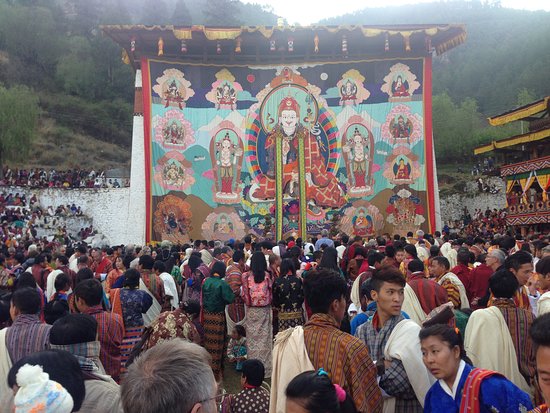
The sacred Thongdrel is a gigantic tapestry displayed on the last day of the annual Paro Tshechu as the highlight of the festival. It is is brought out of the Dzong at approximately 3:00 am in the morning, replete with a ‘Chipdrel,’ or a ‘Traditional Ceremonial Procession.’ Thousands brave the early hours, the cold and the rain every year just to get a glimpse of it. The unfurling takes place very early in order to prevent any damages that could be accrued due to it being exposed to direct sunlight. Therefore it is unfurled at around 3:00 am and rolled back up by 7:00 am. ‘Thongdrel’ literally translates as ‘Liberation upon Sight’ and it is believed that one can cleanse ones sins just by glancing it. It is a Tibetan word that means liberation though seeing. Something is seen that liberates. On a basic level it can be anything that turns the person looking at it toward the spiritual path. On an advanced level it can be the instantaneous act of seeing the world through liberated eyes...the non-deluded eyes of the fully awakened.
The Thongdrel, reputedly Bhutan’s first, features Guru Rinpoche flanked by his two consorts, surrounded by his eight manifestations, the Choe-Lung-Truel Sum (Buddha Amitabha, Avolokitesvara and Namgyalma), and Zhabdrung Ngawang Namgyal. At the bottom of the Thongdrel is yet another figure, that of Lam Ngawang Rabgay, the very personality who made sure that future generations would gaze on him with reverence and eternal gratitude.
Historical records reveal that the gigantic tapestry was commissioned by the second Paro Penlop, Ngawang Choeda, and constructed by Lam Ngawang Rabgay more than 350 years ago. There are many stories about the origin of the Thongdrel. According to one, Lam Ngawang Rabgay sent a trader to Tibet to barter rice for brocade. But the trader was given strict instructions to deal only with the first businessman he would encounter there. The trader followed the Lama’s instructions faithfully and procured a Chinese merchant’s entire stock of brocade – that person was the first businessman that the trader had met in Lhasa. Back in Paro, the trader was amazed to discover that he had unknowingly purchased the exact type and amount of brocade that was required for constructing the Thongdrel.
As per yet another version, the Parop Penlop traveled incognito to Tibet and gambled with Treasurer of Lhasa. The Penlop won, and returned to Bhutan with the treasurer’s entire stock of brocade. The stock he came back with turned out to be exactly sufficient to assemble the Thongdrel.
Historical records reveal that the gigantic tapestry was commissioned by the second Paro Penlop, Ngawang Choeda, and constructed by Lam Ngawang Rabgay more than 350 years ago. There are many stories about the origin of the Thongdrel. According to one, Lam Ngawang Rabgay sent a trader to Tibet to barter rice for brocade. But the trader was given strict instructions to deal only with the first businessman he would encounter there. The trader followed the Lama’s instructions faithfully and procured a Chinese merchant’s entire stock of brocade – that person was the first businessman that the trader had met in Lhasa. Back in Paro, the trader was amazed to discover that he had unknowingly purchased the exact type and amount of brocade that was required for constructing the Thongdrel.
As per yet another version, the Parop Penlop traveled incognito to Tibet and gambled with Treasurer of Lhasa. The Penlop won, and returned to Bhutan with the treasurer’s entire stock of brocade. The stock he came back with turned out to be exactly sufficient to assemble the Thongdrel.
